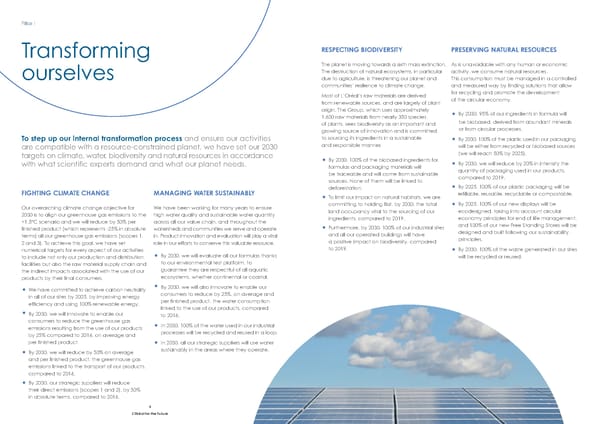8 L’Oréal for the Future Pillar I To step up our internal transformation process and ensure our activities are compatible with a resource-constrained planet, we have set our 2030 targets on climate, water, biodiversity and natural resources in accordance with what scientific experts demand and what our planet needs. FIGHTING CLIMATE CHANGE Our overarching climate change objective for 2030 is to align our greenhouse gas emissions to the +1.5°C scenario and we will reduce by 50% per finished product (which represents -25% in absolute terms) all our greenhouse gas emissions (scopes 1, 2 and 3). To achieve this goal, we have set numerical targets for every aspect of our activities to include not only our production and distribution facilities but also the raw material supply chain and the indirect impacts associated with the use of our products by their final consumers. • We have committed to achieve carbon neutrality in all of our sites by 2025, by improving energy efficiency and using 100% renewable energy. • By 2030, we will innovate to enable our consumers to reduce the greenhouse gas emissions resulting from the use of our products by 25% compared to 2016, on average and per finished product. • By 2030, we will reduce by 50% on average and per finished product, the greenhouse gas emissions linked to the transport of our products, compared to 2016. • By 2030, our strategic suppliers will reduce their direct emissions (scopes 1 and 2), by 50% in absolute terms, compared to 2016. MANAGING WATER SUSTAINABLY We have been working for many years to ensure high water quality and sustainable water quantity across all our value chain, and throughout the watersheds and communities we serve and operate in. Product innovation and evaluation will play a vital role in our efforts to conserve this valuable resource. • By 2030, we will evaluate all our formulas thanks to our environmental test platform, to guarantee they are respectful of all aquatic ecosystems, whether continental or coastal. • By 2030, we will also innovate to enable our consu mers to reduce by 25%, on average and per finished product, the water consumption linked to the use of our products, compared to 2016. • In 2030, 100% of the water used in our industrial pro cesses will be recycled and reused in a loop. • In 2030, all our strategic suppliers will use water sustainably in the areas where they operate. Transforming ourselves RESPECTING BIODIVERSITY The planet is moving towards a sixth mass extinction. The destruction of natural ecosystems, in particular due to agriculture, is threatening our planet and communities’ resilience to climate change. Most of L’Oréal’s raw materials are derived from renewable sources, and are largely of plant origin. The Group, which uses approximately 1,600 raw materials from nearly 350 species of plants, sees biodiversity as an important and growing source of innovation and is committed to sourcing its ingredients in a sustainable and responsible manner. • B y 2030, 100% of the biobased ingredients for formulas and packaging materials will be traceable and will come from sustainable sources. None of them will be linked to deforestation. • To limit our impact on natural habitats, we are committing to holding flat, by 2030, the total land occupancy vital to the sourcing of our ingredients, compared to 2019. • Furthermore, by 2030, 100% of our industrial sites and all our operated buildings will have a positive impact on biodiversity, compared to 2019. PRESERVING NATURAL RESOURCES As is unavoidable with any human or economic activity, we consume natural resources. This consumption must be managed in a controlled and measured way by finding solutions that allow for recycling and promote the development of the circular economy. • By 2030, 95% of our ingredients in formula will be biobased, derived from abundant minerals or from circular processes. • By 2030, 100% of the plastic used in our packaging will be either from recycled or biobased sources (we will reach 50% by 2025). • By 2030, we will reduce by 20% in intensity the quantity of packaging used in our products, compared to 2019. • By 2025, 100% of our plastic packaging will be refillable, reusable, recyclable or compostable. • By 2025, 100% of our new displays will be ecodesigned, taking into account circular economy principles for end of life management, and 100% of our new Free Standing Stores will be designed and built following our sustainability principles. • By 2030, 100% of the waste generated in our sites will be recycled or reused.
 Sustainability Commitment Page 4 Page 6
Sustainability Commitment Page 4 Page 6